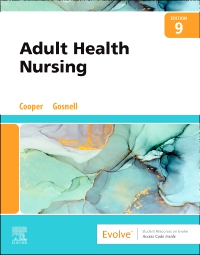
Adult Health Nursing, 9th Edition
Paperback

Now $84.99
Master the LPN/LVN’s role and responsibilities in medical-surgical nursing! With coverage organized by body systems, Adult Health Nursing, 9th Edition provides an essential guide to nursing care for patients with common disorders. Through use of the nursing process, you will develop clinical judgment skills to assess patient needs, develop nursing care plans, and plan effective nursing interventions. Case studies provide practice with critical thinking and clinical judgment, and new Next Generation NCLEX®-format questions help you apply theory to practice. Written by nursing educators Kim Cooper and Kelly Gosnell, this text also helps you prepare for success on the NCLEX-PN® examination.
-
- Step-by-step instructions for skills show clearly defined nursing actions along with the rationales for each.
- Overview of Anatomy and Physiology begins each body systems chapter, and the Introduction to Anatomy and Physiology chapter provides a clear, basic understanding of the A&P that LPN/LVNs need to know.
- The nursing process is applied to the discussion of disorders, and is summarized at the end of each chapter.
- Nursing care plans use a case-study format to emphasize patient goals and outcomes, and include critical thinking questions at the end of each care plan.
- Evidence-Based Practice boxes provide synopses of research articles that apply to nursing, along with nursing implications for the LPN/LVN.
- Safety Alert! boxes cover issues related to safe patient care in a variety of settings.
- Coordinated Care boxes promote comprehensive patient care with other members of the health care team, focusing on prioritization, assignment, supervision, collaboration, delegation, and leadership topics.
- Lifespan Considerations boxes provide age-specific information for the care of the patient.
- Older Adult Considerations boxes provide age-specific information for the care of the aging population, which is often the primary focus of the LPN/LVN nurse.
- Communication boxes illustrate communication strategies through real-life examples of nurse-patient dialogue.
- Patient Teaching boxes focus on three-way communication among the nurse, patient, and family members, and include topics such as hospital discharge instructions.
- Health Promotion Considerations boxes highlight information on wellness and disease prevention, including infection control, diet, and pregnancy.
- Home Health Considerations boxes discuss issues facing patients and their caregivers in the home setting.
- Medication tables provide quick access to action, dosage, precautions, and nursing considerations for commonly used drugs.
- Get Ready for the NCLEX® Examination sections provide key points, review questions, and critical thinking activities to reinforce learning.
-
- NEW! Next Generation NCLEX® case studies and new format questions help you prepare for success on the NCLEX-PN® examination.
- NEW! Discussion of the NCSBN Clinical Judgment Measurement Model helps you develop the skills needed to plan effective nursing interventions.
- NEW! Updated Immune Disorder and HIV/AIDS chapters highlight the newest medical and drug therapies.
- NEW! Updated photos and illustrations show nursing techniques, procedures, and patient care.
-
1. Introduction to Anatomy and Physiology
2. Care of the Surgical Patient
3. Care of the Patient with an Integumentary Disorder
4. Care of the Patient with a Musculoskeletal Disorder
5. Care of the Patient with a Gastrointestinal Disorder
6. Care of the Patient with a Gallbladder, Liver, Biliary Tract, or Exocrine Pancreatic Disorder
7. Care of the Patient with a Blood or Lymphatic Disorder
8. Care of the Patient with a Cardiovascular or a Peripheral Vascular Disorder
9. Care of the Patient with a Respiratory Disorder
10. Care of the Patient with a Urinary Disorder
11. Care of the Patient with an Endocrine Disorder
12. Care of the Patient with a Reproductive Disorder
13. Care of the Patient with a Visual or Auditory Disorder
14. Care of the Patient with a Neurological Disorder
15. Care of the Patient with an Immune Disorder
16. Care of the Patient with HIV/AIDS
17. Care of the Patient with Cancer






 as described in our
as described in our 